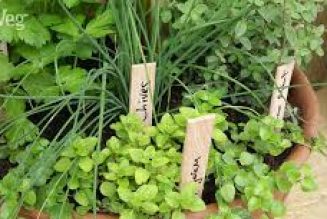Herbs play well with other plants.
In fact, many of them (like rue, catnip, garlic and marigold) make good companion plants for pest control with vegetables and flowers.
(When you don’t want to use pesticides, companion planting can save you a lot of headaches.)
You may even have a lavender plant (at your garden gate, of course), or a rosemary bush as a privacy screen.
That’s all a little different from having a dedicated herb patch.
Herbs may not be the most beautiful plants around. In fact, some of them can get leggy (that’s a polite term for scraggly), and have unimpressive little flowers that look cheerful but hardly photo-worthy.
Still, there’s something magical about a dedicated herb garden.
It’s a powerful feeling, knowing you can run out to a central spot in your garden (say next to the back door) and harvest everything you need for a nice soup, stew or salad in less time than it takes to heat a cup of tea in the microwave
.It’s also a pretty nice feeling come harvest time when you realize all that foliage is enough raw material to make herb wreaths, potpourris, herb blends, teas, remedies — and still have enough left over for next year’s seed.
Herbal Gardens smell wonderful, can help repel bugs when used as companion plants (think catnip, garlic, lavender, basil and marigold) and you can cook with them.
Most are also naturally hardy. It doesn’t get much better than that.
Prepare the plot well.
Herbs aren’t very fussy about fertilizer, but they need a plot that drains well. If you have clay soil, either lighten it to a depth of at least eight inches or install .
Raised bed supports or whole raised like the popular square foot gardens, are big these days.
Patio and deck pots work well too.
You can keep five culinary herbs in one large pot and get enough of a harvest to keep you in herbs over much of the winter.
Most herbs come with lots of valuable information about how to grow them successfully.
Where you plant can be important. If an herb needs full sun, that’s not negotiable.
Full sun means six hours or more of bright light a day.
Less, and the plant will never reach its full potential.A plant in the wrong spot will also be stressed — or more vulnerable to disease and insect attack.
If the directions call for keeping a plant in partial shade, that doesn’t mean full sun with a plant in front of the shade plant.
Dappled light is good, but you need to make sure that a shade-loving herb plant is protected from bright light during the hottest part of the day.
Reading and following the directions will give you the best opportunity to keep all your herbs alive and healthy
.A Child’s First Herb Garden
If you’re trying to get children interested in gardening, give them their own child-sized gardening tools.
Tiny gardening tools are becoming more available these days and keep the frustration level down.
Small hands need small implements.
Children love mint varieties like peppermint and spearmint, as well as other plants in the mint family like lemon balm and catnip.
Other favorites are apple mint, chocolate mint and orange mint.
Mints are very hardy, so they can take quite a bit of abuse, too.
Fast-growing herbs like cilantro are great starter herbs as well.
They offer an instant payoff and can be used in a kid-designed summer recipe like tacos pretty easily.








